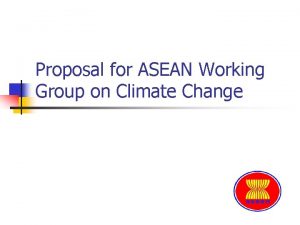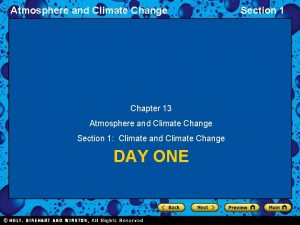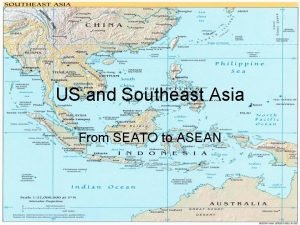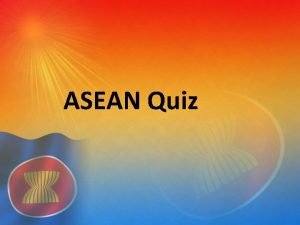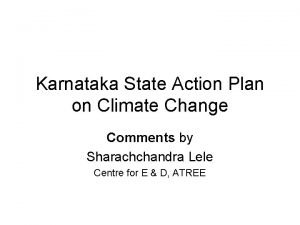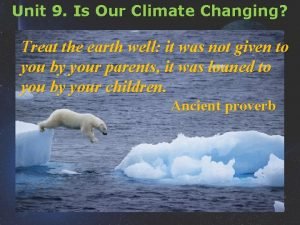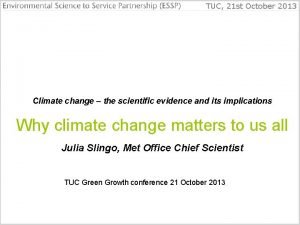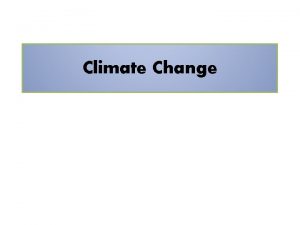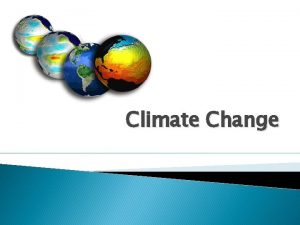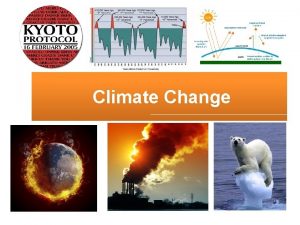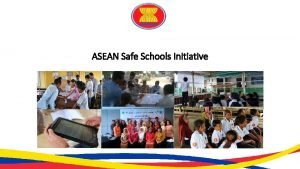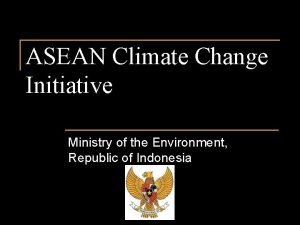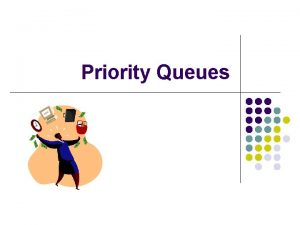ASEAN Climate Change Initiative Proposed Priority Issues and














- Slides: 14

ASEAN Climate Change Initiative Proposed Priority Issues and Common Understanding

ACCI - Mission • the forum should – produce common understanding and if it is possible common position on COP/MOP – produce regional plan of actions (such as haze action plan) and synergized program/efforts in the region to cope with current and future climate risks – establish strategies to integrate the programs/actions (adaptation and mitigation) with sustainable development through optimizing the use of opportunities offered by climate change convention and other related conventions and protocols

ACCI - Objectives • Enhance capacity to further identify and understand impact, vulnerability, and adaptation responses and to select and implement practical, effective and high priority adaptation actions • Enhance development and share and use of experiences and scientific knowledge on climate change • Promote scientific research and human resource development • Enhance integration of actions to adapt to current and future climate change with sustainable development • Strengthen ASEAN contribution to COP/MOP and its subsidiary bodies on the scientific, technical and socioeconomic aspects of impacts, vulnerability and adaptation

ACCI - Activities • Facilitating sharing of information/ knowledge, human resources and technologies within the region in the area of climate change • Developing capacity of member countries in assessing impact of and developing adaptation to current and future climate change • Enhancing collaboration among ASEAN countries and other regional centers to address climate-related hazards, current and future climate changes • Conducting and facilitating action researches for the enhancing capacity of member countries in using climate information to support sustainable development • Developing regional systematic observation system to monitor impact of current and future climate change on vulnerable ecosystem in ASEAN countries • Conducting regional policy analysis for the implementation of climate change convention and protocol

Proposed common understanding: Sharing Information • Increasing the flow of information • Promoting communication among private sector/stakeholders, financial institution • Considering a common approach and framework in setting up emission inventory system in each country • Build network for all stakeholders e. g government agencies, NGOs, and industries on climate change issues

Proposed common understanding: Institutions • Support efforts to establish an ASEAN Clearinghouse • Representation of ASEAN interests in the Executive Board of the CDM and other UNbodies

Proposed Key Issues • Post 2012 • 3 cross-cutting-Issues: technology transfer, capacity building, and financial mechanism (Adaptation Fund) • REDD (Reducing Emission from Deforestation in Developing Countries) • Adaptation

Proposed common understanding: Post-2012 • Request substantive commitment from Annex 1 parties to assist Non-Annex 1 parties in achieving sustainable development particularly through adaptation and mitigation programs • No emission reduction target [and commitment] for Non. Annex 1 parties • To provide positive incentive for voluntary national efforts in reducing emission for Non-Annex 1 parties • [Further commitment] [Higher target] for Annex 1 parties, and explore mechanisms for Non-KP Annex 1 parties to take on emission reduction target and commitment. • to improve regional distribution and quality of CDM projects in Asian region and emphasize its benefit to sustainable development • To ensure that there will be no gap between 1 st and 2 nd commitment period

Proposed common understanding: REDD (plenary) • Support effort undertaken by developing countries to reduce emission from deforestation and the need to have incentives mechanisms to support in the implementation of the effort. The effort shall be characterized as voluntary and should not generate future obligation (goals, targets or timeframes). This is in line with the principle of common but differentiated responsibilities • Urgent need to move ahead with measures to address emission from deforestation as well as the need to consider the issue of degradation at the same time as deforestation • Support effort to reduce emission from deforestation should be able to enhance forest conservation and sustainable forest management • Initiating enabling activities on reducing emission from deforestation for the next 3 -5 year, including capacity building activities and pilot projects on REDD to provide and learning by doing opportunities • Develop methodological work in REDD under SBSTA • Support the development of national forest inventories in developing countries and strengthening capacity for data collection system.

Proposed common understanding: Adaptation (plenary) • take the issue of impacts of climate change and adaptation to climate change as a priority (Mainstream adaptation into national planning) • Increase their involvement in the discussion and negotiation on impact in mitigation and adaptation • Expressly reject the efforts to de-link the international agreements with 4 rd Assessment Report of the IPCC • Develop incentives for developing countries to implement concrete actions on adaptation e. g. pilot projects • Initiate the ASEAN-program on Adaptation Strategies (sister programme)

Proposed common understanding for cross cutting issues: Technology Transfer • Strengthening the EGTT through for example implementation of concrete projects • Explore the possibility of the establishment of a new body for implementation of technology transfer and develop concrete monitoring and performance indicators to track progress on the implementation of technology transfer • To ensure effective technology transfer, to set up some forms of multilateral funding mechanism • To set up and operationalize the funding mechanism to stimulate innovation and the urgent development, deployment, diffusion of environmentally sound technologies from Annex 1 parties to Non-Annex 1 parties for both mitigation and adaptation programs • The need to promote access to financial resources by developing countries for R&D, diffusion, development and transfer of low carbon technologies for adaptation • Public Private Partnership (PPP) to stimulate and facilitate the development of cost effective, climate-friendly technologies and low carbon technologies • Mainstreaming technology transfer by providing enabling conducive environment, enhanced incentives and mechanisms to access these incentives

Proposed common understanding for cross cutting issues: Capacity Building To urge Annex 1 parties and other international organizations to take concrete actions on capacity building programs on mitigation and adaptation for ASEAN countries, such as: • Raising awareness and build the capacity of all stakeholders, where appropriate community partnership, project proponents and operational entities • Networking and information sharing among DNA (DNA Forum) and to increase capacity of DNA • Create conducive policies for CDM Implementation

Proposed common understanding for cross cutting issues: Financial Mechanism • Explore mechanism to develop new funds or access the Special Climate Change Fund (SCCF) to support green economy growth • Establish effective mechanisms for financing climate change activities (SCCF, Adaptation Fund, Least Developed Fund) and access to the funds • Speed up the operationalization of Adaptation Fund and use it to finance concrete adaptation projects and programs in developing countries • Speed up the appointment of institutional entity to manage the Adaptation Fund

 Climate change 2014 mitigation of climate change
Climate change 2014 mitigation of climate change Asean working group on climate change
Asean working group on climate change Burman's priority list gives priority to
Burman's priority list gives priority to Priority mail vs priority mail express
Priority mail vs priority mail express Climate change meaning
Climate change meaning Chapter 13 atmosphere and climate change section 1
Chapter 13 atmosphere and climate change section 1 Chapter 13 atmosphere and climate change
Chapter 13 atmosphere and climate change Seato
Seato Asean quiz bee question and answer
Asean quiz bee question and answer Persuasive essay about global warming
Persuasive essay about global warming Karnataka state action plan on climate change
Karnataka state action plan on climate change What causes wind to blow brainpop
What causes wind to blow brainpop Unit 9 climate change
Unit 9 climate change Conclusion of climate change
Conclusion of climate change Youreuropemap.com
Youreuropemap.com

